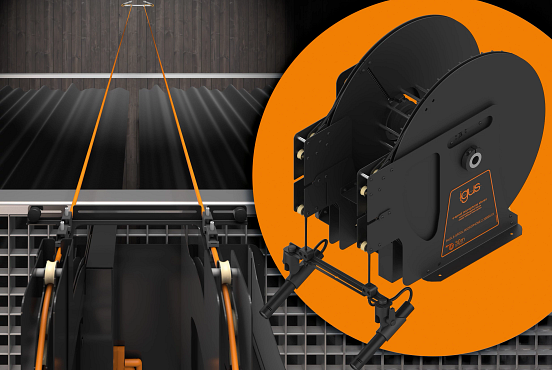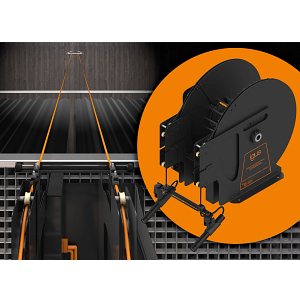New microphone reeler from igus takes the strain off sound engineers
November 12, 2024
e-spool microphone allows for automated feeding of microphone cables that are up to 30m long; doing without slip ring optimises sound quality

Sound engineers in theatres, opera houses and television studios are often under enormous time and expectation pressure. The e-spool microphone from igus provides help. With the new electrically powered microphone reeler, microphone cables of up to 30m can be automatically guided from the ceiling at the touch of a button. A trick in the design optimises transmission quality.
Most people with an office workplace will be familiar with how quickly cables can get on your nerves. One for the webcam, one for the smartphone, others for lamps and keyboard and the cable spaghetti is perfect. However, that’s nothing if you ask professional sound engineers. They sometimes have to suspend 30 microphone cables from the overhead machinery under the ceiling in a concert hall to record an orchestra of 100 musicians for a live television broadcast. “Manual cabling for such large sound installations is not only extremely time-consuming, but also entails the risk of cable breaks,” says Michael Berteit, Sales Manager Engineering Projects and Installation Service at igus. “We developed the e-spool microphone – an automatic cable feed from the ceiling – to relieve sound technicians and protect cables at the same time.”
The new microphone reeler, which is now available, uses an electric motor to guide cables that are up to 30m long towards the ground. It is available in a mono and a stereo version for the parallel guidance of two cables for stereo microphones. Users can either operate the microphone reeler as a stand-alone solution with a wired control unit or integrate it into a higher-level control system via WLAN or radio.
For even better sound: doing without slip ring optimises transmission quality
A special feature of the e-spool microphone is a design trick that improves the sound quality and reliability of the signal transmission. “We wanted to dispense with slip rings. In classic microphone reelers they provide a mechanical interruption of the cable. Our solution prevents the connected end from rotating with the cable drum. These slip rings not only make the systems comparatively expensive, but often also more error-prone. They can even impair the transmission quality,” explains Berteit. igus uses the so-called twisterband instead. The cable, which is fed out of the side of the drum, is inserted into a series of interconnected chain links made of high-performance plastic. When the cable drum rotates, the chain links interlock and perform a spiral rotary movement of up to 7,000°. “Thanks to this globally unique design, we can guarantee uninterrupted sound transmission that is less susceptible to interference. The quality of signal transmission can also improve, enabling sound engineers to create an even better sound experience,” says Michael Berteit.
Special XLR cable carries many times the weight of the microphone
To reduce the risk of failure at important events, igus supplies the e-spool microphone with a special XLR cable. This cable contains an integrated strain relief so that tensile forces do not act on the core. “This means that the cables can easily carry many times the weight of the microphone without being damaged,” says Berteit. The microphone reeler also has an integrated automatic switch-off function. It stops the movement immediately in the event of an unusual load, triggered for example by a snagged cable, and thus prevents damage. Says Berteit: “A cable break is like a dark cloud at the back of most sound engineers’ minds. With our specially developed system and safety features, we want to give them a sense of security so that they can concentrate better on the creative aspect of their work.”



